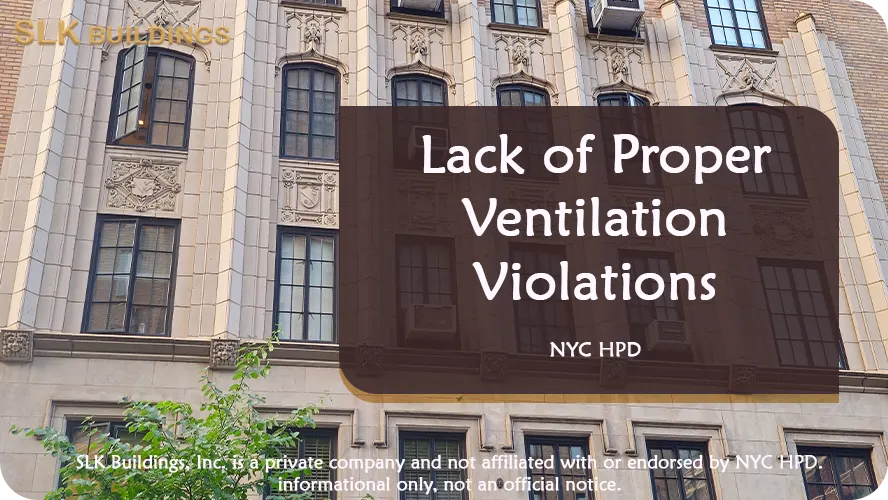
Navigating NYC’s Agencies Authority with Confidence
NYC DOB ~ NYC ~ NYC LPC
📍 Serving: Manhattan, Brooklyn, Bronx, Queens & Staten Island
In the bustling urban landscape of New York City, maintaining proper ventilation within residential buildings is crucial for the health, comfort, and well-being of occupants. The New York City Department of Housing Preservation and Development (HPD) plays a vital role in enforcing regulations to address lack of proper ventilation violations. Adequate ventilation helps to regulate indoor air quality, control humidity levels, and mitigate the spread of airborne pollutants, allergens, and pathogens. However, when ventilation systems are inadequate or compromised, it can lead to a host of issues, including poor indoor air quality, mold growth, and respiratory problems.
In this detailed article, we will explore the complexities of NYC HPD lack of proper ventilation violations, including their causes, implications, enforcement procedures, and strategies for mitigation and prevention.
Understanding NYC HPD Lack of Proper Ventilation Violations:
Lack of proper ventilation violations issued by the NYC HPD identify deficiencies or hazards in the ventilation systems of residential buildings. These violations may stem from various issues, including:
Inadequate Air Circulation: Insufficient airflow within residential units due to blocked vents, obstructed ducts, or poorly designed ventilation systems, leading to stagnant air and poor indoor air quality.
Non-functioning Ventilation Equipment: Failure of ventilation fans, exhaust systems, or air handling units to operate effectively, resulting in inadequate ventilation and humidity buildup.
Lack of Exhaust Ventilation: Absence or inadequate provision of exhaust vents in kitchens, bathrooms, or laundry areas, leading to the accumulation of cooking fumes, moisture, and odors indoors.
Improper Ventilation Design: Ventilation systems that do not meet building codes, standards, or design requirements, resulting in inefficient airflow, uneven distribution of ventilation, or inadequate ventilation rates.
Mold and Mildew Growth: Inadequate ventilation contributing to moisture buildup, condensation, or humidity levels conducive to mold and mildew growth, posing health risks and compromising indoor air quality.
Implications of NYC HPD Lack of Proper Ventilation Violations:
Receiving a lack of proper ventilation violation from the NYC HPD carries significant implications for property owners, landlords, and tenants, including:
Health Risks: Poor ventilation can lead to respiratory problems, allergies, asthma, and other health issues for occupants, particularly vulnerable populations such as children, the elderly, or individuals with pre-existing health conditions.
Mold and Mildew: Inadequate ventilation can contribute to mold and mildew growth, which can damage property, cause odors, and exacerbate respiratory problems for occupants.
Comfort and Well-being: Inadequate ventilation can result in discomfort, stuffiness, and unpleasant odors within residential units, impacting occupants’ quality of life and overall well-being.
Regulatory Compliance: Property owners must demonstrate compliance with HPD regulations, building codes, and health standards by addressing lack of proper ventilation violations and ensuring adequate ventilation within residential buildings.
Legal Obligations: Property owners are legally obligated to address lack of proper ventilation violations promptly, either by repairing ventilation systems, installing additional ventilation equipment, or improving airflow within residential units.
Enforcement Procedures for NYC HPD Lack of Proper Ventilation Violations:
The enforcement process for lack of proper ventilation violations issued by the NYC HPD typically follows these steps:
Complaints or Inspections: HPD receives complaints or conducts routine inspections of residential properties to identify deficiencies or hazards in ventilation systems and assess compliance with ventilation requirements.
Violation Issuance: If violations are observed, the HPD issues administrative notices to property owners, identifying the specific infractions and mandating corrective action within a specified timeframe.
Compliance Period: Property owners are given a designated period to address lack of proper ventilation violations and bring ventilation systems into compliance with HPD regulations, building codes, or health standards.
Re-inspection: After the compliance period expires, the HPD conducts re-inspections to verify that corrective actions have been completed satisfactorily and lack of proper ventilation violations have been rectified.
Penalties and Enforcement Actions: Failure to address lack of proper ventilation violations within the prescribed timeframe may result in monetary penalties, fines, or enforcement actions, such as stop-work orders, vacate orders, or legal proceedings.
Strategies for Addressing and Preventing NYC HPD Lack of Proper Ventilation Violations:
Property owners can implement proactive measures to address and prevent lack of proper ventilation violations, including:
Ventilation Assessments: Conduct regular assessments of ventilation systems within residential properties to identify deficiencies, obstructions, or malfunctions affecting airflow and indoor air quality.
Maintenance and Repairs: Perform routine maintenance and repairs on ventilation equipment, including cleaning ducts, replacing filters, lubricating fans, and repairing or replacing malfunctioning components.
Ventilation Upgrades: Consider upgrading ventilation systems or installing additional ventilation equipment, such as exhaust fans, air purifiers, or heat recovery ventilation units, to improve indoor air quality and airflow within residential units.
Compliance with Codes: Ensure compliance with HPD regulations, building codes, and health standards for ventilation design, installation, operation, and maintenance within residential buildings.
Occupant Education: Educate tenants about the importance of ventilation, proper use of ventilation equipment, and best practices for maintaining indoor air quality and comfort within residential units.
Lack of proper ventilation violations issued by the NYC HPD represent significant concerns for property owners, landlords, and tenants, as they jeopardize indoor air quality, occupant health, and regulatory compliance within residential buildings. By understanding the causes, implications, enforcement procedures, and mitigation strategies associated with lack of proper ventilation violations, property owners can take proactive steps to address deficiencies, maintain compliance with regulations, and ensure the health and well-being of occupants. Through effective ventilation assessments, maintenance, upgrades, and compliance with codes, property owners can create safer, healthier, and more comfortable living environments for residents across New York City.
SLK Buildings resolves HPD Violations and inspections ~ coordinated quickly for urgent cases.
Serving All NYCBorough: Manhattan, Queens, Brooklyn, Bronx and Staten Island
When unsafe conditions are found during corrections, DOB may halt work—see our guide to Stop Work Orders and re-inspection.